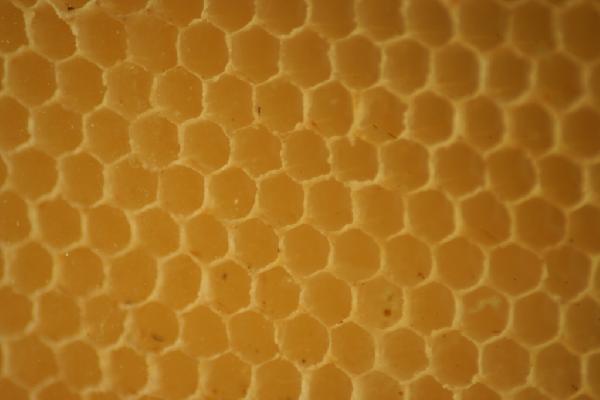
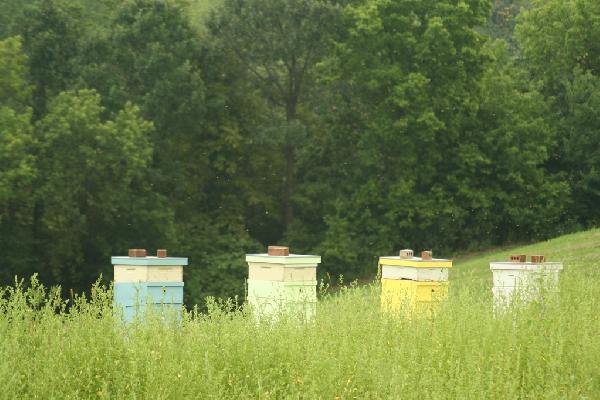
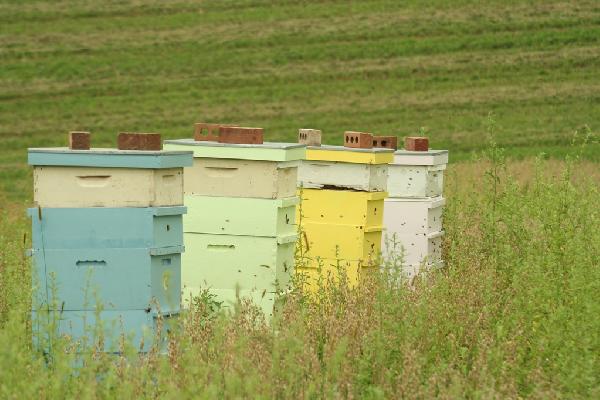
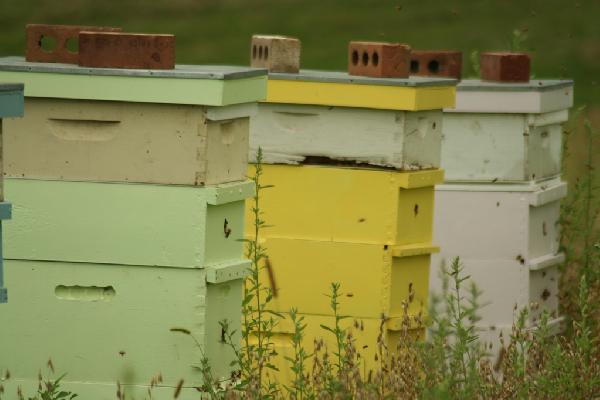
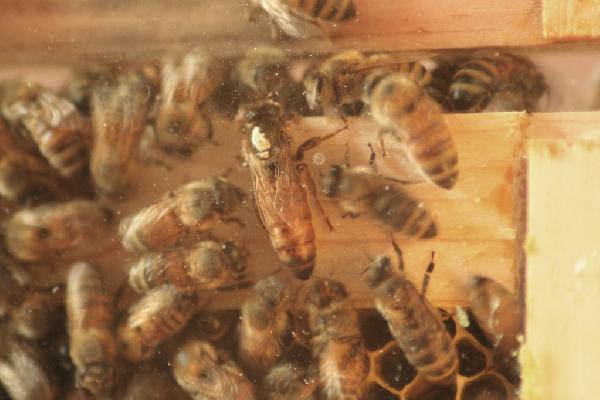



Come out to our Garden Center and watch the bees making honey inside an observation hive.
Frequently Asked Questions About Honey Bees
Why Do Bees Make Honey?
Honeybees are special in that they over winter as a colony unlike wasps and bumblebees (see Biology). The colony does not hibernate but stays active and clusters together to stay warm. This requires a lot of food stored from the summer before. Although a hive only needs 20-30 lb of honey to survive an average winter, the bees are capable, if given the space of collecting much more. This is what the beekeeper wants them to do.
Bees have been producing honey the same way for over one hundred and fifty million years
How Much Honey Can One Beehive Produce?
One hive can produce 60lb (27kg) or more in a good season, however an average hive would be around 25lb (11kg) surplus.
Bees fly about 55,000 miles to make just one pound of honey, that’s 1½ times around the world!
How Does the Beekeeper Get the Honey From the Bees?
The queen bee is kept below the upper boxes in the hive (called ‘Supers’) by a wire or plastic grid that the queen is too large to fit through (called a ‘Queen excluder’). As the bees cannot raise brood above this queen excluder only honey is stored in the supers. As the season progresses the beekeeper adds more supers until the time to harvest the honey.
A special one way valve is then fitted in place of the queen excluder and gradually all the bees are forced into the lowest part of the hive, the beekeeper can simply lift off the ‘super’ boxes containing the honey comb.
The honey is extracted from the comb using centrifugal force in a machine called a spinner looking much like an old-fashioned upright spin dryer.
Romans used honey instead of gold to pay their taxes.
Do the Bees Miss the Honey That is Taken?
No. A strong colony can produce 2-3 times more honey than they need. If necessary the beekeeper can feed sugar syrup in the autumn to supplement for the loss of honey.
Why Are Some Types of Honey Clear and Runny and Other Types Opaque and Hard?
The type of honey made by the bees is dependent on the types of foliage and flowers available to the bees. Crops such as oil seed rape (the bright yellow fields in the spring) produce large quantifies of honey that sets very hard, so hard even the bees could not use it in the winter, garden flowers tend to give a clear liquid honey. If the beekeeper wants to produce a mono honey i.e. clover, orange blossom etc. the beehive is put out of range from other sources. This can be difficult for the small hobbyist and a blend of the season’s honey is usually the result. In the autumn some beekeepers move their hives onto the moors to harvest only the nectar from wild heather. Heather honey is thought to be the king of honeys and has a clear jelly consistency.
How Do Bees Make Honey?
Bees take nectar, which is a sweet sticky substance exuded by most flowers and some insects (Honey dew), and mix it with enzymes from glands in their mouths. This nectar/enzyme mix is stored in hexagonal wax honeycomb until the water content has been reduced to around 17%. When this level is reached the cell is capped over with a thin layer of wax to seal it until the bees need it. This capping indicates to the beekeeper that the honey can be harvested. Capped honey can keep almost indefinitely. Sucrose (nectar) + inverters (bee enzyme) = fructose + glucose = honey.
Perfectly edible honeycomb was found in the tombs of the Pharaohs, over three thousand years old. How’s that for ‘Best Before Dates’.
Does Honey Contain Additives?
No. The only treatment is to filter to remove any wax debris produced during the extraction process.
How Do Bees Make Wax?
The youngest bees cluster in large numbers to raise their body temperature. Wax producing glands under their abdomen slowly secrete slivers of wax about the size of a pinhead. Other worker bees ‘harvest’ these wax scales and take them to the part of the hive requiring the new wax. Bees use about 6lb of honey to produce 1lb of wax.
What is Royal Jelly?
Royal jelly is the food fed to queen bee larvae. It is a creamy white color and is very rich in proteins and fatty acids. It is produced by the mouth glands in young bees. Each queen needs only a teaspoon of royal jelly, so as health product it is very expensive.
Many magical properties are claimed of royal jelly however a skeptical view is probably the healthiest, especially as products sold in health shops can contain as little as 2% of the real thing. Pure royal jelly is almost tasteless.
How Many Legs, Wings and Eyes Do Bees Have?
Six Legs: The rear pair are specially designed with stiff hairs to store pollen when in flying from flower to flower and the front pair have slots for cleaning their antenna.
Four Wings: The front and rear wings hook together to form one big pair of wings and unhook for easy folding when not flying.
Five Eyes: Yes honeybees have five eyes, two large compound eyes and three smaller ocelli eyes in the center of their head.
What's 'the Bees Knees'?
A popular expression is 'It’s the bees knees' meaning its ideal, or the best. However although bees have legs with joints like any insect their joint have nothing like a knee cap therefore bees do not have knees as such.
What is the Difference Between Honeybees, Wasps (Yellowjackets) and Bumblebees?
Honeybees are the highest form of insect life; they live in a well organized colony that does not need to hibernate. They produce honey and store it in wax comb and use the same hive from one year to the next.
The typical maximum population is 35,000-50,000 bees.
Wasps start in the spring with a single queen wasp that has hibernated under leaves or in cracks. The queen wasp builds a new hive constructed from paper and about the size of a golf ball. This hive (bice) builds up through the summer, however no honey is stored. In the autumn the colony organization breaks down, with homeless wasps becoming an increasing nuisance around bins and rubbish. Typical maximum population is 2,000.
Bumblebees or as the Victorian’s called them ‘Humble bees’ like wasps, only the queen hibernates and survives the winter. In the spring the queen bumblebee seeks an old mouse or vole hole and builds within it a nest of leaves and moss. She constructs nodular wax cells and incubates her young as a bird would. As her first offspring hatch and begin to fly the queen increasingly stays within the hive to produce young. Bumblebees do make a small amount of honey and store it in one special cup like cell. There is no more than a tablespoon at any time. The typical maximum population is only 50-150.
How Many Types of Bees Are in a Honeybee Colony?
There are three types: a single queen, thousands of female workers and, in the summer, hundreds of male drones. The drone bee does no work however in the early autumn they are evicted by the workers and die.
What Does the Queen Bee Do?
The major purpose of the queen is to lay eggs. During April and May she lays day and night, each egg taking about 20 seconds. She lays over 2000 eggs a day; more than her own body weight. The queen mates only once and holds sufficient sperm from the male drones to lay eggs for 3-5 years; incidentally the drone bee dies in the process which must come as a major disappointment for him.
There are 3 types of wax cell used for eggs. In the smallest cells (5mm diameter) she lays fertilized eggs, which in 21 days produce the female worker bees. In larger cells (7mm diameter) unfertilized eggs are laid which in 24 days become the male drone bees, production of offspring not requiring mating is known as parthenogenesis. A very special cell that hangs vertically downwards is used to produce new queens. A colony producing queen type cells warns the beekeeper of an impending swarm.
A male drone bee has no father but does have a grandfather!
A healthy queen bee is continually emitting pheromones (a bee perfume) that only the bees in the hive can smell. These pheromone odors tell the bees in the colony that the queen is still with them and all is well in the hive. This chemical pheromone communication is quite sophisticated and the ‘personality’ of a beehive will change if the beekeeper changes an old queen for a young one. In this way a beekeeper has some control over the temper and enthusiasm of a colony.
Does the Queen ‘Rule’ the Colony?
No, the queen is simply an egg-laying machine.
The queen bee has a smaller brain than a worker bee.
Queen Making and Swarming
1. Bees construct up to 20 wax queen cells, which are acorn like and point downwards.
2. The queen lays fertilized eggs in each queen cell.
3. The young (nurse) bees feed the young queen larvae with a rich creamy food called Royal Jelly, and extend the cell downwards until it is about 25mm in length.
4. Nine days after laying, the first queen cell is sealed with a layer of wax capping.
5. This is the time for a large swarm (called a prime swarm) of bees leaves the hive led by the older bees. The old queen has been starved of food to make her lighter and able to fly. The older bees can cajole the old queen to join the swarm.
6. Eight days later first virgin queen leaves her cell. Two things can now occur, either the first virgin queen leads a smaller swarm from the hive (called a cast) or she locates the other queen cells and kills her sisters by stinging through the wax wall of their cells.
7. About one week later the young queen takes her first flight to orientate her to her new surroundings.
8. The queen will shortly take several matting flights in which she will mate with up to 20 male bees called drones.
9. Three days later the mated queen will begin to lay fertilized eggs.
10. This queen will stay with the colony until at least the following year when she too may lead a prime swarm.
How Do Bees Make a Queen?
The making of a queen is triggered usually by a combination of conditions such as congestion in the hive and lack of egg laying space this culminates in a swarm.
Why is There Only One Queen?
It is not understood (by man) why bees will only tolerate one queen but any attempt to introduce a second queen results in her death. If a queen dies unexpectedly during the summer the bees are able to make an emergency queen from eggs younger than 3 days old.
How Long Does a Bee Live?
In the summer a worker bee only lives for about 40 days. As no young are raised over the winter months, the workers born in the autumn will live until the following spring. A queen can live up to 5 years however for the beekeeper a queen is past her prime in her third year.
How Do the Bees Share Out All the Different Jobs in a Hive?
When a bee is born its first job is to clean out the cell in which she was born. Jobs are then allocated on the basis of age.
Duties of Worker Bees
1-2 days - Cleans cells and keeps the brood warm
3-5 days - Feeds older larvae
6-11 days - Feeds youngest larvae
12-17 days - Produces wax, Builds comb, Carries food, Undertaker duties
18-21 days - Guards the hive entrance
22+ days - Flying from hive begins, Pollinates plants, Collects pollen, nectar & water.
How Many Bees Are in a Beehive?
High summer about 35,000 dropping to around 5,000 in the winter.
What Causes Bees to Swarm?
A swarm is the natural way for bees to multiply and produce new colonies. It is normally the culmination of queen rearing.
What is Bee ‘Dancing’?
Bees need to communicate with each other to pass on the location of food sources. To do this bees have evolved a unique dance language that can be understood by us. A worker bee returning from a rich source of food will ‘dance’ on the vertical comb surface by running in a circle, on each revolution the bee will bisect the circle at an angle. The angle with respect to 12 O’clock represents the angle to fly with respect to the sun.
If the bee ran from 6 to 12 O‘clock i.e. straight up, this would say fly directly towards the sun ‘.
And 7 to 1 O’clock would mean fly just to the right of the sun, 12 to 6 O’clock ‘Fly directly away from the sun’. In other words the bees translate the angle to the sun as an angle to the vertical.
To represent distance the bee ‘wiggles’ its abdomen whist crossing the circle, the more wiggles the greater the distance.
So a bee will ‘say’ to it’s friends ‘Fly over there for about a 1 mile and you will find something that tastes like this’. Pretty Smart!
How Does a Bee Navigate?
As mentioned above the bees use the position of the sun and there is evidence of sensitivity to the earth’s magnetic field. Also bees eyes are sensitive to polarized light which penetrates through even thick cloud so they are able to ‘see’ the sun in poor weather.
Can a Bee See Color?
Yes, their eyes are sensitive more to the blue end of the spectrum and into ultra violet. Flowers reflect large amounts of ultra violet light and to a bee will be very bright. Bees are totally red blind.
Do Bees Sleep?
No, but during the night most bees remain motionless reserving their energies for the next day.
How Far Can Bees Fly?
It is possible for bees to fly as far as 5 miles for food; however an average distance would be less than a mile from the hive. A strong colony flies the equivalent distance of to the moon every day!
How High Can Bees Fly?
A honey bee will not fly much higher than the height of any obstacle in its path. The bee will learn to fly straight out from its colony at high speed and be most surprised if it strikes a new obstacle such as you standing in the way. It may lash out and you will receive a sting so be careful when walking close to the front of a busy beehive.
Mating drones will fly up to 30 meters above ground to find a queen and can go much higher if warm rising thermal air carries them so.
How Fast Can Bees Fly?
Normal top speed of a worker would be about 15-20mph (21-28km/h) when flying to a food source and about 12mph (17km/h) when returning laden down nectar, pollen, propolis or water.
Do Bees Catch Any Diseases?
Yes, they’re several diseases, some more serious than others. They are not infectious to humans but dangerous for the bee. Some of the most serious AFB (American Foul Brood) and EFB (European Foul Brood) are normally treated by destroying the colony. If left, they can spread throughout out the whole apiary and affect surrounding beekeepers. Spores from AFB can remain dormant for over 50 years in old beekeeping equipment and cause problems decades later.
Why Do Bees Collect Pollen?
Pollen is mixed with water and to form a type of bread that is fed to the growing larvae. It provides rich source of proteins and fat whilst honey provides energy (carbohydrate). Bees collect about 20kg of pollen every year that’s 1 million pollen loads at 20mg a go.
Do Bees Hibernate During Winter?
No, bees over winter as a strong colony clustered together and using their bodies to generate heat. This cluster is about the size of football, with bees taking turns to be on the cold outside.
Why Does a Bee Sting?
A bee only stings under two conditions: To protect the colony or when frightened.
How Does a Bee Navigate?
As mentioned above the bees use the position of the sun and there is evidence of sensitivity to the earth’s magnetic field. Also bees eyes are sensitive to polarized light which penetrates through even thick cloud so they are able to ‘see’ the sun in poor weather.
Why Does a Bee Die When It Stings?
When a bee stings, barbs in the lance of the sting cause it to firmly stick into the victim pulling out the venom sacs and glands when the bee is shaken off. The venom sac muscles continue to pump after these organs have been torn from the dying bee. Only the female workers and the queen can sting, the queen having a smooth sting which she uses to kill other queens.
What Are ‘Killer Bees’?
This over dramatic description hit the headlines due to events in America. Research work carried out by the Brazilian government in the 1950’s, trying to improve the local strain of honeybee by cross breeding with African bees went wrong. The African bee was known to be a good producer of honey, however had a reputation for over defensive behavior when protecting it’s colony. The experiment was supposed to contain the African bees and prevent them from spreading however some swarms did escape and thrived in the forests of Brazil. The resultant cross strain produced an aggressive bee compared with the native bee and has gradually spread outside of Brazil and through other South American countries. This ‘Africanized’ strain can now be found in southern states of the USA producing the media hype of ‘Killer Bees’. Although an individual bee has the same sting and venom as a British bee, they are much more easily induced to sting and chase people.
What Is Varroa?
Varroa is parasite that lives only on honeybees. It is a small crab like insect with eight legs and about 1.2mm across and used to live only on the Asian honeybee (Apis cerana). Due to man moving bees around the world this parasite transferred to the European honeybee (Apis mellifera) which cannot tolerate this pest. There is no effect on honey but it has been a huge problem for beekeepers throughout most of the world. Due to Varroa, wild feral colonies of bees will die out and only well managed colonies will survive.
The most common method to treat Varroa is towards the end of the season once the honey has been removed, slow release chemicals are introduced into the colony. Other more natural methods are being tried with varying degrees of success; research is on going with the ultimate goal of breeding a resistant strain of honey bee.
Bees Know the World is Round
During swarming dancing (see Bee Dancing above) occurs to pass on information about a possible new home. This can go through the night, so without the sun what do the bees use? The answer is they dance at angles calibrated to the sun on the other side of the world! Bees knew the world was round about 25 million years before man!
The Schafberg Experiment
An interesting experiment known as the SCHAFBERG experiment (named after the mountain) demonstrates the sophistication of bee navigation. The only source of food for a colony of bees was put on the far side of a mountain; the bees could not fly over the mountain only around it. What direction would the bees indicate in their dancing? The answer was surprising, the bees indicated the direction exactly across the mountain at an angle they had never flown but had calculated in their head. The distance indication however, was for the long flight around the hill.
What Do I Do If I Get Stung?
Bees will not generally sting if unprovoked usually the bee has been trapped in hair or crushed. When close to a beehive avoid flapping your arms and moving rapidly, if the bees are antagonized, walk away through undergrowth or trees if possible. If stung scrape the sting out with your fingernail as the sting still pumps venom for some time after the bee has left.
The record number of sustained stings one person has had, and survived to count them is 2,243. Ouch!
Is It True That a Bee Sting Can Be Good For You?
Old Beekeepers seldom suffer from arthritis or rheumatism and in Russia bee venom is used directly as a treatment of joint conditions. Research is ongoing.
What Do I Do If I See a Swarm of Bees?
Don’t panic, bees in a swarm are universally in a good mood. They cannot easily sting even if antagonized as they have gorged themselves with honey and cannot get their bodies into the best position to sting. If the swarm is not causing a nuisance then leave it, gradually the bees will cluster in a bush or tree and remain there for up to 3 days. During that time scouts will be sent out to look for a new home, the only problem may be they will choose your chimney so put your fire/ heating on low and enjoy their visit.
How Do Beekeepers Catch a Swarm?
A swarm is actively looking for a home, so if the beekeeper puts a nice hive with perhaps some old honey comb in it close to where the swarm has settled, then it is easy to persuade them to take up residence. Normally a few bees are dropped into the hive and they then ‘fan’ their scent to the other bees once it has been ‘approved’. It is a dramatic sight to see a swarm ‘marching’ into a new hive.
Bees already in residence perhaps in a chimney or old tree must be removed with their honeycomb containing the young grubs and the queen. If the bees cannot be reached then the beekeeper is helpless and the council or local pest control can destroy the colony.
Apart From Honey Are Bees Useful?
Yes very, the pollination benefit of bees is calculated to help the economy by millions of pounds per annum. Certain crops yield up to 25-40% more if efficiently pollinated and farmers in some areas of the world pay beekeepers to put hives into their fields and orchards. In the USA alone bees pollinate about ten billion dollars worth of crops per year (1997). In addition to pollination, bees produce wax for candles and Royal Jelly. During the Middle Ages one of the most important jobs in an Abbey was the Beekeeper, as a huge quantity of wax was constantly required for the ceremonial candles.
Is Beekeeping Hard Work?
No. In terms of time spent, it requires about ½ hour per hive per week from mid April thru August. In addition, honey is extracted once or twice a year.
The first record of people keeping bees was in Spain about 6000 B.C.
How Much Will It Cost Me To Keep Bees?
For the clothing and tools about $150 and a good second hand hive with bees about $100-$180.
Will I Get Stung If I Keep Bees?
Yes. A few people are allergic, but most will swell for a short time and then gradually become more immune.
A Beekeeper Uses Smoke To ‘Calm’ The Bees—How Does This Work?
Bees are woodland insects and evolution has taught them to fear fire more than anything else. When smoke enters a hive the bees are immediately diverted to eat as much honey as possible as there may be a need to abandon the hive at a moment’s notice. This diverts them whilst the beekeeper takes their home apart.
How Does a Beekeeper Find the Queen?
Some times with difficulty, she is normally close to the newly laid eggs and her long body and large legs make her stand out. Once found many beekeepers put a small dot of paint on the back of the queen bee that makes her much easier to find the next time. The paint comes in five colors each color representing the year. As Queens seldom live longer than five years, five colors are sufficient.
Color Year Ending
White
1 or 6
Yellow
2 or 7
Red
3 or 8
Green
4 or 9
Blue
0 or 5
Modern Beehives Look Boring. Why Don’t Many Beekeepers Use The Traditional Looking White Terraced Hive?
Although the old style hives look pleasant at the foot of the garden there is nearly twice as many components in their construction. Internally the old hive is the same as a modern hive but is clumsier to use. Incidentally the ‘old’ style is called a WBC hive after its inventor William Broughton Carr and the most popular standard ‘hobby’ hive in Britain is the ‘National’ hive.


